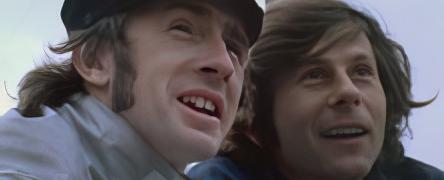


At least that’s what the two men, along with producer Brett Ratner, are hoping. All three recently gathered (with the director Skyping in from France, where he continues to reside) at New York’s Crosby Street Hotel for a press conference and screening of Polanski’s re-cut and restored 1971 documentary “Weekend of a Champion,” ahead of its theatrical re-release on November 22.
More than four decades ago, Polanski spent three days filming his friend, “The Flying Scot,” as he prepared to compete in, and win for a second time, the Monaco Grand Prix. Both men were at the peak of their fame — Polanski still riding the success of “Rosemary’s Baby” and Stewart the most recognizable and decorated racer in the sport.
The film covers the excitement of the race — eager fans, flowing champagne, with cameos by Princess Grace, Ringo Starr, and Joan Collins — but also the odd details of how a champion prepares. We see Stewart shaving (upon cutting himself he calls to Polanski “it’s good for your movie — you love blood”), getting dressed in two layers of white turtlenecks, and expressing nervousness ahead of the competition. But despite the cinema verite detail and glimpse inside one of the most glamorous sports in the world, “Weekend of a Champion” received only limited showings upon its first release and never made it to the United States.
During the press conference, Polanski explained how so many years later he decided to take another look at his all-but-forgotten documentary. The London lab where the negatives for the film were being kept called to ask if they should ship them back to Polanski or throw them out.
“My instruction was, ‘hold on, wait a second,’” said Polanski. “I looked at the film and I liked it after almost 40 years. I decided I will give it a new life and that’s what we saw today.”
He re-edited it for pacing and added a present-day segment at the end in which he and Stewart, seated in the same Monte Carlo hotel room where many of the original scenes took place. In the film, the two old friends look back at the time, joking about Stewart’s extravagant sideburns and reflecting on how the sport and their relationship to it has changed over the decades.
Polanski explained that these additions and changes were made to help it appeal to a contemporary audience.
“You have it in a present shape, you have it in a pace which today is acceptable,” he said. “And then when I had it all put together — I would not say entirely — but in a good shape to revisit it again with Jackie, that’s what we did, literally.”
Stewart described the experience as “stepping back in history.” Not only in terms of the glamour (and sometimes questionable fashion choices) of the 1970s Formula 1 milieu, but unfortunate lack of safety for the racers at the time. He pointed out that when the film was made, driver deaths were commonplace, and those who raced for five years had an astonishing two-out-of-three chance of being killed on the road.
“[W]hen you see the cars passing the pits as they are, there was no barrier in front of the pits for example. And there’s hundreds of gallons of high octane fuel and hundreds of people standing there without any protection,” said Stewart. “Today, because of what we’ve done in safety, that would never have been allowed to happen.”
These changes have been largely thanks to Stewart himself, who after losing too many of his friends pushed for major reforms in the sport. Due to the much greater level of safety, Formula 1 has not had a fatality since the death of Ayrton Senna almost 20 years ago.
When asked his advice to aspiring filmmakers, Polanski also struck a more sober note.
“It’s a question of patience and perseverance, that’s all I can tell you,” he said. “You can’t teach talent but you can tell someone how to sustain the adversity which is an enemy constantly on set.”
Quick Links
Legal Stuff


